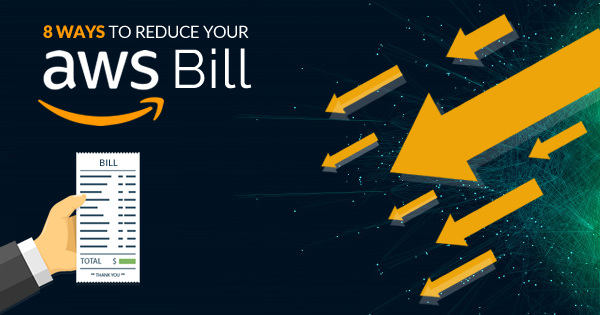Majority of companies have recognized the importance of cloud recently. This has led to a large number of companies choosing different cloud service providers; mostly Amazon Web Services (AWS). Companies recognized that it is better to pay AWS bill rather than bleeding away their money on capital expenses for on-premises data centers.
AWS has become one of the most favorites for businesses due to the wide range of IT resources such as SaaS applications, IT infrastructure, analytics tools and bandwidth provided on one platform. However, many organizations tend to deal with cloud issues such as overuse, suboptimal application placement, and unused capacity. These issues only end up in a rise in AWS billing for businesses and can also mean an unpredictable economic model for their AWS infrastructure.
Best Practices to Reduce Your AWS Bill
When the discussion on AWS bill arises, it directly refers to the economically scalable costs of AWS services, which have reduced considerably. However, it does not mean that if the services are cheap, you can keep them in your kitty even if you don’t need them. After all, you have to pay from your pocket and AWS cost reduction can give you opportunities for reinvesting the saved money in your company.
The main objective of cloud architecture solutions such as AWS is cost-effectiveness, and if you are not paying attention, a higher AWS bill is completely ruining that! In the following discussion, we shall explore eight different ways to reduce AWS bill for your business based on widely recommended and proven suggestions.
1. Trust the AWS Billing Report
The first suggestion to reduce AWS costs is the use of an AWS billing report. The complex aspects noted in cloud pricing models have evolved as a crucial challenge for businesses. To improve simplicity in these models, AWS has provided its dashboard for billing. The dashboard can be used for observing your AWS bill and the distribution of costs among different services such as EC2, S3 or EBS.
On the other hand, the dashboard is not suitable for many organizations, especially for obtaining detailed data to obtain insights. However, you always have the option of choosing the billing report provided by Amazon. The billing report of AWS is accessible through download in the form of a zipped .csv file with details of different billable items in different lines.
On the other hand, AWS cost optimization best practices suggest the use of custom tags to import the data into an analytics tool and classify the costs. The costs could be classified based on projects, departments, features or the criteria specified by the organization. The AWS applications such as Cost Explorer and Trusted Advisor could also prove to be exceptional instruments for obtaining better insights as well as support in identifying trends in AWS costs.
You can be lost into the number of services offered by the AWS. To help you through the way, here is the list of Top AWS Services you should know about.
2. Monitor Service Usage
As we were discussing above, tools such as Trusted Advisor along with CloudWatch could be reliable components in AWS to help in reducing your AWS bill. But how? These are in-built management and monitoring tools that provide instance metrics. When you use these tools to evaluate the data collected, it can be helpful for a proper review of workloads, determining the need for scaling instance size and identifying non-production instances.
Trusted Advisor can help in running configuration checks to find out idle resources and also provides real-time guidance based on AWS best practices. CloudWatch service could be used for establishing alarms, and tracking and monitoring key metrics as well as log files. This can help in the automatic reaction of modifications in the use of AWS resources.
You can reduce AWS costs by clearly identifying metrics that are crucial to the performance of an application. The CloudWatch service has also been proven as a trusted source for evaluating custom metrics that are created by the applications. Therefore, monitoring and tracking the use of resources can help to reduce AWS costs.
Also Check: Best AWS Cost Optimization Tips
3. Choosing the Right Instance Type
Various types of instance groups are associated with different costs. Therefore, to keep your AWS bill optimized, you need to use cost-effective instances. It is important to choose the instance which is appropriately suited for your application workload. To improve your workloads along with measures to reduce AWS bill, you need to consider the specific use case to determine the amount of memory, and the type of processing unit needed.
The instance resource would have to be optimized at least two times in a year to match with the real and existing workload. The best practice that can be recommended in this case to reduce your AWS bill, would be the tagging of your instance. Tags could help monitor the cost per hour for running systems in real-time and calculations, thereby providing suggestions for optimizing costs. You can ensure tagging in the organization by using open source tools which restrict instances without tagging.
4. Auto-scaling can Work Wonders!
Another one of the AWS cost optimization best practices is the use of auto-scaling. Alignment of your resources with customer demand is one of the major reasons to choose cloud computing. Therefore, you can choose architecture designs with the use of Auto Scaling that can manage variable demands. Auto Scaling makes sure that resources are available for the application when required, and they are turned off when not in use. The Auto Scaling services are also helpful in detecting non-functional instances as well as automatically terminating them and relaunching a new version.
5. Make the Most of Spot Instances
Spot instances could also be your proven choice to reduce AWS billing. The Spot instances could be helpful for AWS to ensure allocation of unused capacity to users at reduced rates. You can use spot instances for accessing computer resources at 90% lesser rates than regular prices. At lower costs, you could be able to access higher capacity, and spot instances could be terminated after two minutes of receiving the notification.
If your cloud infrastructure is associated with using container technologies such as Docker, stateless web servers and high-performance Big Data systems, then spot instances could be the right approach for reducing costs. You can find many presentations on spot instance best practices that can help reduce the AWS bill and learn more about spot instances.
You could also take a look at AWS Spot Fleet which helps in defining a capacity poll that can have a spot as well as on-demand capacity. The various options can help in the selection of low-cost instances as well as choose additional capacity on the grounds of preferences.
Confused while choosing an AWS certification? If so, check out our previous article on AWS Certifications and find which one is right for you.
6. The Right Selection of Storage Class
Appropriate choice of storage class options is also recommendable for AWS cost reduction. Presently there are five tiers of AWS S3 object storage, and it is crucial to find out the reason and time for using each for optimization of costs. The cost for each storage tier comprises of the actual storage amount, the volume of data transfer, number of HTTP GET requests and HTTP PUT requests.
The S3 standard is good for general purposes in the case of frequently accessed data. The S3 standard-infrequent access (IA) is suited for less frequently used data that needs the resiliency level same as that of the standard storage class. However, users can access it rapidly according to the need.
The AWS S3 One Zone- Infrequent Access is used for low pricing and data is stored in a single availability zone along with lower resiliency. AWS Glacier is suited for data that has to be retained for more than 90 days and is suited if you can wait for almost 3-5 hours for accessing or restoring data. You can reduce the AWS bill by optimizing the cost of data storage through the implementation of object lifecycle management.
7. Clip off the Unused Instances
Elimination of the idle instances could be another efficient way to lower down AWS costs. This is recommended especially during weekends and at the end of a workday. The AWS services such as OpWorks and Elastic Beanstalk could help developers for consistent and fast deployment or redeployment of applications without having to care for the underlying infrastructure.
However, just because you have the money to run your application on powerful instances. You can use AWS CloudFormation for defining the infrastructure for the code, thereby increasing the ease for creating templates of AWS resources. This approach for cloud computing with AWS could be a reliable source of realizing the concept of ephemeral workloads.
As a result, you could be able to save a lot of money by deleting or shutting down AWS resources that are not in use. Furthermore, if you are doubtful of needing a presently unused instance at a later stage, then it is better to choose the right instance which does not make a hole in your wallet.
8. Technical Experts to the Rescue
The final recommendation for reducing your AWS bill would be consultation with technical experts. Even though auto-scaling tools can help in reducing costs, you can end up with concerns of unavailability of resources. Generally, you would be on auto-pilot mode, and this can lead to waste of resources and capacity.
Technical experts could use their awareness of the cloud computing landscape in general as well as their real-time experience with different cloud service providers. A lot of experience of technical experts can help in obtaining an unbiased review of your AWS cloud framework. As a result, you would not only receive suggestions for cutting costs but also ensure the strategic improvement of your complete cloud strategy.
Looking for a good AWS consulting services provider for your business? Here is the list of top AWS Consulting Company, choose the one and save your AWS bills.
Closing Words
Based on an observation of the tips mentioned above to reduce your AWS costs, it can be concluded that rightful use of resources is important. It is reasonable to put resources to rest when you are not using them, whether it is your smartphone or the lightbulbs in your home. So, why should you refrain from being a little less frugal with AWS services?
Nowadays, companies are looking for AWS consultants who could help them to cut down their AWS bills. So, if you are an AWS professional, learn these best practices and validate your knowledge with one or more AWS certifications to get a better opportunity. To help you along your journey, we have launched AWS certifications training courses. Check them out, enroll now, and get ready to become an AWS certified cloud professional.
Go ahead and help businesses to cut their AWS bills!
- Top 20 Questions To Prepare For Certified Kubernetes Administrator Exam - August 16, 2024
- 10 AWS Services to Master for the AWS Developer Associate Exam - August 14, 2024
- Exam Tips for AWS Machine Learning Specialty Certification - August 7, 2024
- Best 15+ AWS Developer Associate hands-on labs in 2024 - July 24, 2024
- Containers vs Virtual Machines: Differences You Should Know - June 24, 2024
- Databricks Launched World’s Most Capable Large Language Model (LLM) - April 26, 2024
- What are the storage options available in Microsoft Azure? - March 14, 2024
- User’s Guide to Getting Started with Google Kubernetes Engine - March 1, 2024





